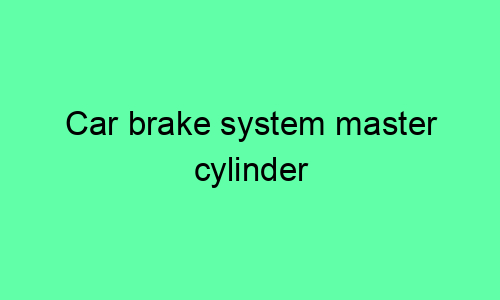Car Brake System Master Cylinder
What is a Master Cylinder?
A master cylinder is a key component of a car’s brake system. It is responsible for converting the force applied to the brake pedal into hydraulic pressure that is then used to activate the brake calipers. The master cylinder is typically located under the hood of the car, near the firewall.
How Does a Master Cylinder Work?
When you step on the brake pedal, a piston in the master cylinder is pushed inward. This piston moves hydraulic fluid through a series of brake lines to the brake calipers. The brake calipers then use the hydraulic pressure to activate the brake pads, which press against the brake rotors to slow or stop the car.
Types of Master Cylinders
There are two main types of master cylinders: single-piston and tandem-piston. Single-piston master cylinders have one piston that is used to activate both front and rear brakes. Tandem-piston master cylinders have two pistons, one for the front brakes and one for the rear brakes. Tandem-piston master cylinders are more common in newer cars because they provide better brake performance.
Master Cylinder Problems
Master cylinders can develop a variety of problems over time. Some of the most common problems include:
- Leaking brake fluid: A leak in the master cylinder can cause the brake fluid to leak out, which can lead to a loss of brake pressure and a decrease in braking performance.
- Sticking piston: A sticking piston can prevent the master cylinder from generating enough hydraulic pressure to activate the brake calipers. This can lead to a loss of braking performance.
- Corrosion: Corrosion can damage the master cylinder and its internal components, which can lead to a loss of brake performance.
Master Cylinder Replacement
If your master cylinder is damaged or malfunctioning, it will need to be replaced. Replacing a master cylinder is a complex procedure that should be performed by a qualified mechanic. The cost of replacing a master cylinder can vary depending on the make and model of your car.
Master Cylinder Maintenance
There are a few things you can do to help maintain your master cylinder and ensure that it is functioning properly. These include:
- Checking the brake fluid level regularly: The brake fluid level should be checked monthly and topped off as needed. A low brake fluid level can lead to a loss of brake pressure and a decrease in braking performance.
- Flushing the brake fluid: The brake fluid should be flushed every two years or 30,000 miles. Flushing the brake fluid removes contaminants and helps to prevent corrosion.
- Inspecting the brake lines for leaks: The brake lines should be inspected for leaks every six months. A leak in the brake lines can cause the brake fluid to leak out, which can lead to a loss of brake pressure and a decrease in braking performance.
Conclusion
The master cylinder is an important component of a car’s brake system. It is responsible for converting the force applied to the brake pedal into hydraulic pressure that is then used to activate the brake calipers. By understanding how a master cylinder works and how to maintain it, you can help to ensure that your car’s brakes are always functioning properly.






